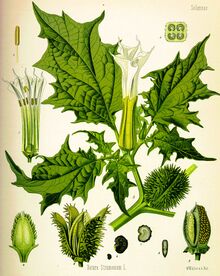This is an unofficial archive of PsychonautWiki as of 2025-08-11T15:14:44Z. Content on this page may be outdated, incomplete, or inaccurate. Please refer to the original page for the most up-to-date information.
Template:SubstanceBox/Datura: Difference between revisions
Jump to navigation
Jump to search
>MountainTraveler Data and numbers have been off for a while. Preface needed more detail. |
>Blackhole m Reverted edits by MountainTraveler (talk) to last revision by Isaak |
||
| Line 8: | Line 8: | ||
<!-- Modules --> | <!-- Modules --> | ||
|ModuleSource=true | |ModuleSource=true | ||
|ModuleCombination=false | |ModuleCombination=false | ||
|ModuleStructure=false | |ModuleStructure=false | ||
|ModuleNomenclature=true | |ModuleNomenclature=true | ||
| Line 17: | Line 17: | ||
|PhotoImageFile=File:Datura_inoxia.jpg | |PhotoImageFile=File:Datura_inoxia.jpg | ||
|PhotoImageWidth=220px | |PhotoImageWidth=220px | ||
|PhotoImageCaption= | |PhotoImageCaption=Drawing of D. stramonium | ||
<!-- Combination --> | <!-- Combination --> | ||
| Line 40: | Line 40: | ||
<!-- Nomenclature --> | <!-- Nomenclature --> | ||
|NameCommon=[[common name::Datura]], | |NameCommon=[[common name::Datura]], [[common name::Jimson Weed]] | ||
|NameSubstitution=Angel's | |NameSubstitution=Angel's Trumpets, Devil's Apple, Thorn Apple, Stinkweed, Devil's Weed, Moonflower | ||
|NameSystematic= | |NameSystematic= | ||
| Line 48: | Line 48: | ||
|EffectClass=[[Deliriant]] | |EffectClass=[[Deliriant]] | ||
|ChemicalClass=[[Tropane alkaloid]] | |ChemicalClass=[[Tropane alkaloid]] | ||
<!-- Dosage/Duration --> | <!-- Dosage/Duration --> | ||
|SmokedROA= | |SmokedROA=false | ||
|SmokedROA_Collapsed=true | |SmokedROA_Collapsed=true | ||
|SmokedROA_Caption= | |SmokedROA_Caption= | ||
|SmokedROA_Bioavailability= | |SmokedROA_Bioavailability= | ||
|SmokedROA_Threshold=< | |SmokedROA_Threshold=< x mg | ||
|SmokedROA_Light= | |SmokedROA_Light=x - x mg | ||
|SmokedROA_Common= | |SmokedROA_Common=x - x mg | ||
|SmokedROA_Strong= | |SmokedROA_Strong=x - x mg | ||
|SmokedROA_Heavy=> | |SmokedROA_Heavy=> x mg | ||
|SmokedROA_TimelineFile= | |SmokedROA_TimelineFile= | ||
|SmokedROA_TimelineWidth= | |SmokedROA_TimelineWidth= | ||
|SmokedROA_Duration= | |SmokedROA_Duration=x minutes | ||
|SmokedROA_Onset= | |SmokedROA_Onset=x seconds | ||
|SmokedROA_Peak= | |SmokedROA_Peak=x minutes | ||
|SmokedROA_Offset= | |SmokedROA_Offset=x hours | ||
|SmokedROA_Aftereffects= | |SmokedROA_Aftereffects=x hours | ||
|OralROA=true | |OralROA=true | ||
|OralROA_Collapsed=false | |OralROA_Collapsed=false | ||
|OralROA_Caption= | |OralROA_Caption= | ||
<br>''' | <br>'''The dosage differs wildly between plants.''' | ||
|OralROA_Bioavailability= | |OralROA_Bioavailability= | ||
|OralROA_Threshold= | |OralROA_Threshold= | ||
|OralROA_Light= | |OralROA_Light= | ||
|OralROA_Common= | |OralROA_Common= | ||
|OralROA_Strong= | |OralROA_Strong= | ||
|OralROA_Heavy= | |OralROA_Heavy= | ||
|OralROA_TimelineFile= | |OralROA_TimelineFile= | ||
|OralROA_TimelineWidth= | |OralROA_TimelineWidth= | ||
|OralROA_Duration= | |OralROA_Duration=8 - 18 hours | ||
|OralROA_Onset=[[Oral min onset time::20]] - [[Oral max onset time::120]] [[Oral onset time units::minutes]] | |OralROA_Onset=[[Oral min onset time::20]] - [[Oral max onset time::120]] [[Oral onset time units::minutes]] | ||
|OralROA_Comeup=[[Oral min comeup time::60]] - [[Oral max comeup time::120]] [[Oral comeup time units::minutes]] | |OralROA_Comeup=[[Oral min comeup time::60]] - [[Oral max comeup time::120]] [[Oral comeup time units::minutes]] | ||
|OralROA_Peak=5 - 12 hours | |OralROA_Peak=5 - 12 hours | ||
|OralROA_Offset=2 - | |OralROA_Offset=2 - 3 hours | ||
|OralROA_Aftereffects= | |OralROA_Aftereffects=6 - 24 hours | ||
}} | }} | ||
Latest revision as of 05:14, 2 June 2024
| SubstanceBox/Datura | |||||||||||||||||||||||
|---|---|---|---|---|---|---|---|---|---|---|---|---|---|---|---|---|---|---|---|---|---|---|---|
 |
|||||||||||||||||||||||
| Chemical Nomenclature | |||||||||||||||||||||||
| Common names | Datura, Jimson Weed | ||||||||||||||||||||||
| Substitutive name | Angel's Trumpets, Devil's Apple, Thorn Apple, Stinkweed, Devil's Weed, Moonflower | ||||||||||||||||||||||
| Class Membership | |||||||||||||||||||||||
| Psychoactive class | Deliriant | ||||||||||||||||||||||
| Chemical class | Tropane alkaloid | ||||||||||||||||||||||
| Routes of Administration | |||||||||||||||||||||||
|
|||||||||||||||||||||||